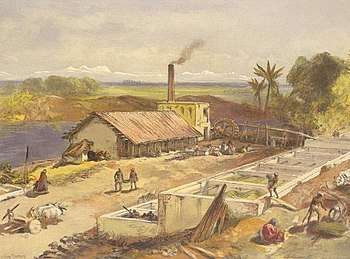Indigo revolt

The Indigo revolt (or Nil vidroha) was a peasant movement and subsequent uprising of indigo farmers against the indigo planters that arose in Bengal in 1859.
Cause lead to revolt - Indigo planting in Bengal dated back to 1777. With expansion of British power in the Nawabs of Bengal, indigo planting became more and more commercially profitable because of the demand for blue dye in Europe. It was introduced in large parts of Burdwan, Bankura, Birbhum, North 24 Parganas, and Jessore (present Bangladesh). The indigo planters persuaded the peasants to plant indigo instead of food crops. They provided loans, called dadon, at a very high interest. Once a farmer took such loans he remained in debt for his whole life before passing it to his successors. The price paid by the planters was meagre, only 2.5% of the market price. The farmers could make no profit growing indigo. The farmers were totally unprotected from the indigo planters, who resorted to mortgages or destruction of their property if they were unwilling to obey them. Government rules favoured the planters. By an act in 1833, the planters were granted a free hand in oppression. Even the zamindars sided with the planters. Under this severe oppression, the farmers resorted to revolt.
The Bengali middle class supported the peasants wholeheartedly. Bengali intellectual Harish Chandra Mukherjee described the plight of the poor farmer in his newspaper The Hindu Patriot. However the articles were overshadowed by Dinabandhu Mitra, who depicted the situation in his play Nil Darpan.His play created a huge controversy which was later banned by the East India Company to control the agitation among the Indians.
The revolt
The revolt started from the villages of Gobindapur and Chaugacha[1] in Krishnanagar, Nadia district, where Bishnucharan Biswas and Digambar Biswas first led the rebellion against the planters. It spread rapidly in Murshidabad, Birbhum, Burdwan, Pabna, Khulna, and Narail. Some indigo planters were given a public trial and executed. The indigo depots were burned down. Many planters fled to avoid being caught. The zamindars were also targets of the rebellious peasants.
_Kuthi_at_Mongalganj_04.jpg)
The revolt was ruthlessly suppressed. Large forces of police and military, backed by the British Government and the zamindars, mercilessly slaughtered a number of peasants. British police mercilessly hanged great leader of indigo rebels Biswanath Sardar alias Bishe Dakat in Assannagar, Nadia after a show trial. Some historians opined that he was the first martyr of indigo revolt in undivided Bengal. In spite of this, the revolt was fairly popular, involving almost the whole of Bengal. The Biswas brothers of Nadia, Kader Molla of Pabna, and Rafique Mondal of Malda were popular leaders. Even some of the zamindars supported the revolt, the most important of whom was Ramratan Mullick of Narail.[2]
The effect on the British rulers in India
The historian Jogesh Chandra Bagal describes the revolt as a non-violent revolution and gives this as a reason why the indigo revolt was a success compared to the Sepoy Revolt. R.C. Majumdar in "History of Bengal"[3] goes so far as to call it a forerunner of the non-violent passive resistance later successfully adopted by Gandhi. The revolt had a strong effect on the government, which immediately appointed the "Indigo Commission" in 1860.[4] In the commission report, E. W. L. Tower noted that "not a chest of Indigo reached England without being stained with human blood".[5]
Cultural effects
Dinabandhu Mitra's 1859 play Nil Darpan is based on the revolution. It was translated into English by Michael Madhusudan Dutta and published by Rev. James Long. It attracted much attention in England, where the people were stunned at the savagery of their countrymen. The British Government sent Rev. Long to a mock trial and punished him with imprisonment and fine. Kaliprasanna Sinha paid the fine of Rs 1000 for him.
The play was the first play to be staged commercially in the National Theatre in Kolkata.
See also
References
- ↑ Bhattacharya, Subhas (July 1977). "The Indigo Revolt of Bengal". Social Scientist. 5 (60): 17. JSTOR 3516809.
- ↑ Bhattacharya, Subhas (July 1977). "The Indigo Revolt of Bengal". Social Scientist. 5 (60). JSTOR 3516809.
- ↑ Majumdar, R. C. The Government in 1860 enacted the Indigo Act, according to which no planter could be forced to cultivate indigo against his will. The History of Bengal ISBN 81-7646-237-3
- ↑ Bhattacharya, Subhas (July 1977). "The Indigo Revolt of Bengal". Social Scientist. 5 (60): 14. JSTOR 3516809.
- ↑ The Calcutta Review. University of Calcutta. 1861-01-01. p. 291.